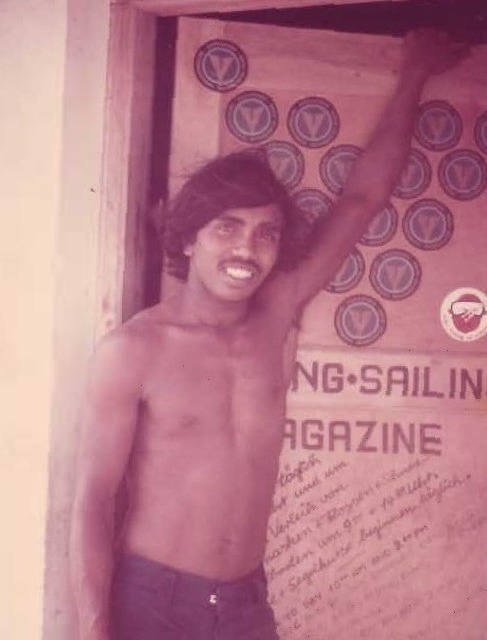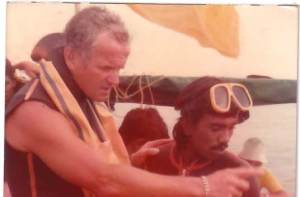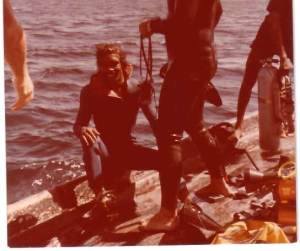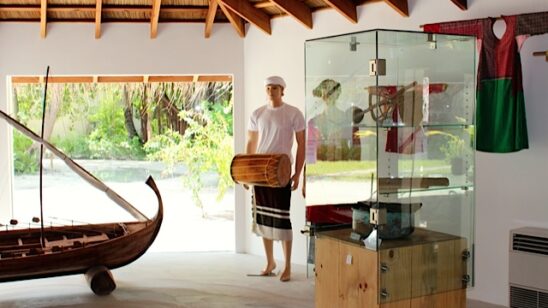
Mohamed Waheed; A Diver’s Life
[vc_row][vc_column width=”1/1″][vc_column_text]Nashiu Zahir[/vc_column_text][/vc_column][/vc_row][vc_row][vc_column width=”1/1″][dt_gap height=”10″][/vc_column][/vc_row][vc_row][vc_column width=”1/2″][vc_column_text]
Mohamed Waheed, a smiling, swarthy man in his 60s, sits with a cup of coffee and begins to reveal how he found himself in the diving business. He hails from Haa Alif Haorafushi, and came to Male’ after completing his schooling on the island. “In those days we were taught in Dhivehi, we weren’t taught English,” he recalls. “You basically had to memorise lessons and recite them to your teacher.”
He was fifteen when he came to Male’, and his arrival happened to coincide with Vihamanaafushi’s (now Kurumba) recruitment drive. There, he initially worked as a room boy. “The salary of a room boy at the time was 60 Rufiyaa,” Waheed says. “But then I caught the eye of one of the two owners of the resort, Kerafaa Ahmed Naseem, who told me to transfer to the engine room where I could get a considerable raise, to 160 Rufiyaa a month. That was how much a government secretary earned.”
While Waheed was at Vihamanaafushi, the Italian traveller George Corbin came to the Maldives. He and his group of travellers brought with them a compressor and cylinders, not for scuba diving as such, but to hunt fish by spearfishing. “The compressor was kept at the engine room under our care,” says Waheed. “There I learnt how to fill the cylinders up with air.”
Soon, in 1974, the first dive school was established in Vihamanaafushi by a German named Band Lonkovski. “For a particular excursion on a liveaboard vessel to Alif Atoll, they wanted a person to operate the compressor and the generator,” Waheed says. “So I went with them on that trip, and worked on that vessel for some time.”
When he returned to Vihamanaafushi, the dive school owner wanted a ‘compressor boy’ and took Waheed in. “It was very time consuming to fill up the tanks with air,” says Waheed. “We would start around midnight and we’d be done by around seven in the morning.” Waheed soon began to tire of the job. “It wasn’t challenging enough for me, anybody could do it,” he says. “I thought it was time for me to do something else.”
Not long after, Waheed began to look towards diving. “I got into diving because I was captivated by the underwater world,” he says. “My curiosity was piqued when I saw guests go diving with such delight and enthusiasm. I used to snorkel while I was a compressor boy; I had to deliver the gas cylinders and such to the divers, you know…! I saw the guests doing their exercises underwater while I was snorkelling and I got a peek of the things to come. So I decided to learn how to dive and talked to my superiors who were very supportive.” Waheed completed a CMAS dive master in the mid-1970s, when he was in his late teens, and there was no looking back for him. “It’s a remarkable world down below,” he says. “And some of the sights that I’ve seen are firmly embedded in my mind even today.”
Dives back then were conducted in a more primitive manner. “We used to go to dive spots on inflatable rafts with an outboard motor,” says Waheed. “We didn’t have buoyancy control devices (BCDs). Buoyancy was maintained using our lungs. And the only person with a life vest was the dive instructor.”
[/vc_column_text][/vc_column][vc_column width=”1/2″][vc_column_text]
After the departure of Lonkovski, noted diver Herwarth Voigtmann took over the dive school in Kurumbaa Village (formerly Vihamanaafushi). However, he soon left for Bandos and another German, Heinz Schimke joined Kurumbaa Village to manage their dive school. Schimke then left for Kuramathi and Waheed followed him. Waheed then had a chance to work in Bandos. While in Bandos, he got an opportunity to work for a company in Abu Dhabi as a commercial diver. “That was around 1982,” says Waheed. “I worked with that company until my return to the Maldives in 1993.” He got into contact with Herwarth Voigtmann who was stationed in Maayaafushi and began working there.
Maayaafushi’s owner took the dive school from Voigtmann and began operating the dive school himself. After a few months, the owner handed over the management to Waheed, who operated the dive school until the resort was sold. Waheed then found work as a dive instructor on a liveaboard vessel: “Dream Voyager”. It was there that he fortuitously met his would-be partners, Uwe and Andrea Klar. “They told me that they were very interested in operating a dive school here in the Maldives,” says Waheed. “I was very sceptical at first; you can imagine how many times I’d heard that before. But they were very serious. So we set up a company, Meridis Maldives Private Limited, and I was able to find a suitable place for a dive school at Dhonakulhi resort in Haa Alif Atoll.”
Since then, Meridis has expanded to two other resorts. The company’s dive centres in all three locations offer full PADI certified courses and streamlines the processes for guests. “All they have to do is to get to the dive school on time and get on board the dhoni,” Waheed says. “They won’t have to carry anything. We also have our own dive vessels, prepared to our specifications to cater to our divers. I don’t believe that hired vessels will offer the quality we want to our clients. It’s part of our service to offer an elegant vessel for transport. They have restrooms and showers. Guests can come on board after their dives, have a shower and dry themselves off and relax until they’re brought to the hotel. That’s the kind of service we offer.”
Divers in the Maldives are mostly European, Waheed observes. “Chinese make a significant part of guests in a resort but they are not divers. They would go snorkelling, or on short dives. Europeans are scarce these days.” Waheed’s main clients are European. “We get enough clients though, for instance, in Dhonveli, there is still a good percentage of Europeans so we still get divers.”
Environmental awareness has impacted on diving, according to Waheed. “Those days people might sit on corals during their dive or break off a piece of coral with their fins,” he says. “They didn’t know any better. People now know what they should and shouldn’t do, that the marine environment depends on good diving practices for sustainability. ”
There are more divers today than there was earlier; the market has expanded according to Waheed. “Even when you look at local divers, when I started diving there were only two other men,” he says. “Today there are many, and it’s not an exclusively male thing anymore. There are lots of female dive instructors and dive masters. There is great potential in this industry even now.”
[/vc_column_text][/vc_column][/vc_row]




